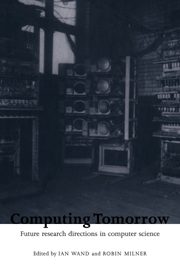Book contents
- Frontmatter
- Contents
- Preface
- Contributors
- 1 The Complexity of Algorithms
- 2 Building Novel Software: the Researcher and the Marketplace
- 3 Prospects for Artificial Intelligence
- 4 Structured Parallel Programming: Theory meets Practice
- 5 Computer Science and Mathematics
- 6 Paradigm Merger in Natural Language Processing
- 7 Large Databases and Knowledge Re-use
- 8 The Global-yet-Personal Information System
- 9 Algebra and Models
- 10 Real-time Computing
- 11 Evaluation of Software Dependability
- 12 Engineering Safety-Critical Systems
- 13 Semantic Ideas in Computing
- 14 Computers and Communications
- 15 Interactive Computing in Tomorrow's Computer Science
- 16 On the Importance of Being the Right Size
- References
- Index
2 - Building Novel Software: the Researcher and the Marketplace
Published online by Cambridge University Press: 10 December 2009
- Frontmatter
- Contents
- Preface
- Contributors
- 1 The Complexity of Algorithms
- 2 Building Novel Software: the Researcher and the Marketplace
- 3 Prospects for Artificial Intelligence
- 4 Structured Parallel Programming: Theory meets Practice
- 5 Computer Science and Mathematics
- 6 Paradigm Merger in Natural Language Processing
- 7 Large Databases and Knowledge Re-use
- 8 The Global-yet-Personal Information System
- 9 Algebra and Models
- 10 Real-time Computing
- 11 Evaluation of Software Dependability
- 12 Engineering Safety-Critical Systems
- 13 Semantic Ideas in Computing
- 14 Computers and Communications
- 15 Interactive Computing in Tomorrow's Computer Science
- 16 On the Importance of Being the Right Size
- References
- Index
Summary
Abstract
Much of the software we use today arose from new ideas that emanated from researchers at universities or at industrial research laboratories such as Xerox PARC. Researchers who are concerned with building novel software are usually keen to get their creations out into the field as soon as possible. This is partly because they may get extra brownie points from their research sponsors, but, perhaps more importantly, because usage in the field often leads to new insights, which in turn result in the next step forward for the research.
Nevertheless, building something that people will use means making big sacrifices in the research aims. In particular the prime quality of any research, novelty, must be kept in check.
My work for the past decade has been in on-line documents, a topic that is fairly close to the market-place. I will relate some experiences of the trade-offs between research aims and the market-place, and put this in the context of the future lines of development of the subject.
Introduction
The aim of this chapter is different from most of the others. I wish to consider researchers at the applied end of the spectrum: people engaged in creating novel software tools. I will analyse my experience over the past ten years in trying, reasonably successfully, to create novel software tools in the electronic publishing area – specifically in hypertext – and will try to draw some general lessons which may help future research.
A typical aim of the software tools researcher is to pioneer a novel interface style, such as a successor to the desktop metaphor, or to pioneer a new approach to an application area – the Walter Mitty dream that most of us have is a breakthrough equivalent to the discovery of the spreadsheet.
- Type
- Chapter
- Information
- Computing TomorrowFuture Research Directions in Computer Science, pp. 21 - 32Publisher: Cambridge University PressPrint publication year: 1996



